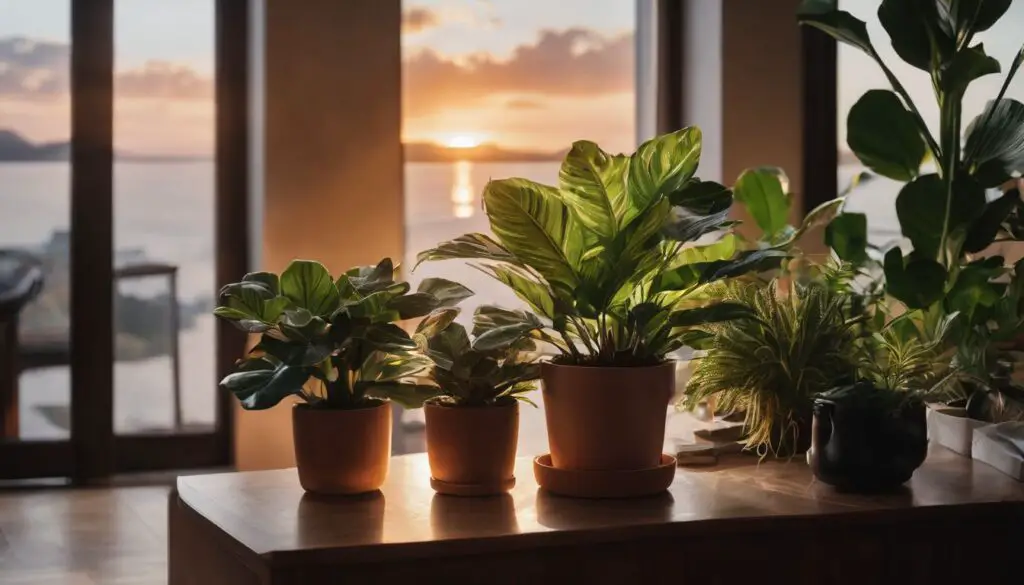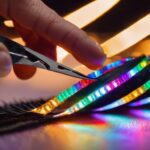Are you wondering if the LED lights in your home can be used to grow indoor plants? This is a common question, especially as more people turn towards indoor gardening. By delving into the science of light and photosynthesis, this article will help guide you through choosing the right type of lighting for your houseplants.
Can i use normal led light to grow plants indoor? Yes, you can use normal LED lights for indoor plant growth, but they may have limitations in providing the ideal spectrum and intensity of light needed for optimal photosynthesis. LED grow lights, designed for plants, are more effective because they offer the right spectrum and are energy-efficient. To use regular LED lights successfully, consider factors like light intensity, duration, and the specific needs of your plant species.
Keep reading to uncover whether standard LEDs can promote healthy plant growth or if special growing lights are necessary.
Key Takeaways
- Regular LED lights can support plant growth indoors, but they may have limitations in providing the ideal spectrum of light and intensity for optimal photosynthesis.
- LED grow lights are specifically designed to provide the right wavelengths of light that plants need for healthy development and growth.
- Factors to consider for successful plant growth under regular LED lights include light intensity, duration, spectrum, distance from plants, specific light needs of different plant species, and supplementing with natural sunlight when possible.
- LED grow lights offer benefits such as energy efficiency, cost – effectiveness, longer lifespan, lower heat generation, and the ability to mimic the sun’s natural spectrum.
Understanding the Science of Light for Plant Growth

Light plays a crucial role in photosynthesis, the process by which plants convert light energy into chemical energy to fuel their growth and development.
The role of light in photosynthesis

Plants use light to make food. This process is called photosynthesis. In photosynthesis, plants turn water and carbon dioxide into oxygen and glucose. Glucose is a type of sugar that plants use for energy.
To do this, they need light. The light gives them the power to make their own food. So, no light means no food for plants!
Different wavelengths of light and their effects on plants

Plants respond differently to different wavelengths of light. They use specific colors of light for various stages of growth. For instance, blue light promotes vegetative growth, while red light stimulates flowering and fruiting.
Plants also need a balance of both blue and red wavelengths for overall healthy growth. LED grow lights are designed to provide the optimal spectrum of light that plants need for photosynthesis, using a combination of blue and red LEDs.
This ensures that indoor plants receive the right amount and type of light they require to thrive and flourish.
Choosing the Right Bulb for Indoor Plant Growth

There are several types of bulbs to consider for indoor plant growth, including incandescent, halogen, fluorescent tubes, and LED bulbs.
Incandescent bulbs

Incandescent bulbs are not the best option for growing indoor plants. They produce a lot of heat and emit light that is too concentrated in the red and infrared spectrum, which is not ideal for plant growth.
Incandescent bulbs also have a shorter lifespan compared to other types of bulbs. While they can provide some light for plants, it is generally recommended to use other types of lights, such as LED grow lights, which are more efficient and specifically designed to support plant growth.
Halogen bulbs

Halogen bulbs are another type of artificial light that can be used for indoor plant growth. They emit a bright, white light that is similar to natural sunlight. However, they are not as energy-efficient as LED lights and generate more heat, which can potentially damage plants if they are placed too close.
Halogen bulbs also have a shorter lifespan compared to LED lights, so they may need to be replaced more frequently. While halogen bulbs can support plant growth, LED grow lights are generally a better choice due to their energy efficiency, longer lifespan, and ability to provide the optimal spectrum of light for photosynthesis.
Fluorescent tubes

Fluorescent tubes are another type of artificial light that can be used for indoor plant growth. They emit a wide spectrum of light that is suitable for photosynthesis, including both blue and red wavelengths.
This makes fluorescent tubes a good option for supporting plant growth. However, it’s important to note that not all fluorescent tubes are created equal when it comes to supporting plant growth.
Some may have lower light intensity or the wrong color spectrum, which can limit their effectiveness in promoting healthy plant growth. It’s recommended to choose fluorescent tubes specifically designed for horticulture or grow lights to ensure optimal results when using this type of lighting for indoor plants.
LED bulbs

LED bulbs are commonly used for indoor plant growth because they provide the right spectrum of light that plants need to grow. These bulbs are energy-efficient, emit little heat, and have a longer lifespan compared to other types of bulbs.
LED grow lights can mimic the sun’s natural light and provide plants with the necessary wavelengths for photosynthesis. While regular LED lights can support plant growth, it is important to ensure that they deliver enough photosynthetically active radiation (PAR) light for optimal results.
Full spectrum LED grow lights are often recommended as they offer a balanced combination of colors that promote healthy plant growth.
LED grow lights

LED grow lights are a popular choice for indoor plant growth. These lights provide the optimal spectrum of light that plants need for photosynthesis. They are energy-efficient, cost-effective, and generate less heat compared to other types of lighting.
LED grow lights also have a longer lifespan, making them a durable option for long-term use. When using LED grow lights, it’s important to position them properly and monitor the light intensity to ensure healthy plant growth.
Different plant species may have specific light requirements, so it’s essential to consider their individual needs when using LED grow lights.
Can Regular LED Lights Support Plant Growth?

Regular LED lights have limitations when it comes to supporting plant growth, and there are factors to consider for successful plant growth under these lights.
Limitations of regular LED lights

Regular LED lights have some limitations when it comes to supporting plant growth. One of the main limitations is that they may not provide enough of the right type of light for optimal photosynthesis.
Plants need a specific spectrum of light, including red and blue wavelengths, for efficient growth. Regular LED lights might not emit these wavelengths in sufficient quantities.
Another limitation is that regular LED lights may not deliver enough light intensity for plants to thrive. Light intensity refers to how bright the light is, and plants require a certain level of brightness to grow properly.
If regular LED lights are not bright enough, they may not provide the necessary energy for photosynthesis.
It’s worth noting that while regular LED lights have their limitations, they can still be used successfully with some adjustments. For example, placing the plants closer to the light source or using multiple regular LED lights can help increase both the light intensity and spectrum provided to plants.
Factors to consider for successful plant growth under regular LED lights

To ensure successful plant growth under regular LED lights, consider the following factors:
- Light intensity: Make sure the LED lights provide enough brightness for your plants. Brighter lights help with photosynthesis and overall growth.
- Light duration: Determine the appropriate amount of time to keep the LED lights on each day. Most indoor plants need about 12-16 hours of light per day.
- Light spectrum: Regular LED lights might not have the ideal spectrum for plant growth. Look for LED bulbs that emit a balance of blue and red light, as these wavelengths are crucial for photosynthesis.
- Distance from plants: Place the LED lights at an optimal distance from your plants to avoid burning or shading them. Follow the manufacturer’s guidelines for recommended distances.
- Plant species: Different plants have varying light requirements. Research and understand the specific light needs of your indoor plants to ensure they receive adequate lighting.
- Supplementing with natural sunlight: If possible, expose your plants to natural sunlight whenever available. This can provide additional nutrients and beneficial wavelengths of light.
Benefits of Using LED Grow Lights for Indoor Plants

LED grow lights provide the optimal spectrum of light for plant growth, ensuring that plants receive the necessary colors and wavelengths for photosynthesis.
Optimal spectrum for plant growth
Plants need a specific spectrum of light for their growth. This includes different colors like blue and red, which are essential for photosynthesis. LED grow lights provide this optimal spectrum by emitting the right wavelengths of light that plants need to thrive.
They offer a balanced combination of colors that promote healthy growth and encourage flowering and fruiting in indoor plants. Using LED grow lights ensures that your plants receive the right kind of light they require for maximum growth and productivity without wasting energy on unnecessary wavelengths.
Energy efficiency and cost-effectiveness
LED lights are highly energy-efficient and cost-effective for indoor plant growth. They consume less electricity compared to other types of bulbs, saving you money on your energy bills.
LED grow lights also have a longer lifespan, so you won’t need to replace them as often. Additionally, they emit very little heat, reducing the risk of overheating your plants or causing fire hazards.
With their efficiency and durability, LED lights provide an economical option for maintaining healthy and thriving indoor plants without breaking the bank.
Long lifespan and lower heat generation
LED lights have a longer lifespan compared to other types of light bulbs, making them a cost-effective choice for indoor plant growth. They also produce less heat, which is beneficial for the health of plants as excessive heat can cause damage.
The energy efficiency and lower heat generation of LED lights make them an ideal option for providing long-lasting and safe lighting solutions for indoor gardens.
Tips for Using LED Grow Lights Successfully

Position and expose your plants to LED grow lights properly, monitor and adjust the light intensity as needed, supplement with natural sunlight when possible, and consider the specific light needs of different plant species.
Proper positioning and duration of light exposure
- Place the LED grow lights about 6 – 12 inches above the plants for optimal light intensity.
- Adjust the height of the lights as the plants grow to maintain the recommended distance.
- Provide at least 12 – 16 hours of light exposure per day for most indoor plants.
- Avoid leaving the lights on 24/7, as plants need a period of darkness for growth and rest.
- Use a timer to automate the light schedule and ensure consistency.
- Rotate or reposition the plants regularly to ensure even light distribution and prevent one – sided growth.
- Monitor plant response to light exposure – if they appear leggy or have burned leaves, adjust the distance or duration accordingly.
- When using natural sunlight in combination with LED lights, place plants near a window with adequate sunlight and supplement with LED lights as needed.
Monitoring and adjusting light intensity
To ensure successful plant growth with LED lights, it is important to monitor and adjust the light intensity. Different plants have different light requirements, so it’s essential to find the right balance.
One way to monitor light intensity is by using a lux meter or a smartphone app that measures brightness in lux units. Aim for at least 1000-2000 lux for most houseplants, but some plants may require more or less depending on their needs.
If the light intensity is too low, you can increase it by moving the plants closer to the LED lights or by using additional lighting sources. On the other hand, if the light intensity is too high, you can move the plants farther away from the lights or use curtains or shades to filter out some of the light.
Supplementing with natural sunlight when possible
When growing plants indoors, supplementing with natural sunlight can be beneficial for their overall growth and health. Natural sunlight provides a full spectrum of light that plants need for photosynthesis.
While LED lights can support plant growth, natural sunlight contains additional wavelengths that may not be present in artificial light sources. Placing your indoor plants near a sunny window or using a sunlamp can help provide them with the necessary light intensity and spectrum they require.
Just ensure to monitor the amount of direct sunlight exposure to prevent heat stress or burning of the plants.
Considering the light needs of different plant species
Different plant species have varying light requirements for optimal growth. Some plants, such as succulents and cacti, thrive in bright indirect light, while others like ferns and peace lilies prefer lower levels of indirect light.
It is important to research the specific lighting needs of the plants you want to grow indoors and choose LED lights that can provide the appropriate spectrum and intensity of light.
For example, leafy green plants generally require higher amounts of blue light for foliage development, while flowering plants may benefit from a combination of red and blue light to promote blooming.
fINALLY, CAN I Use Normal Led Light To Grow Plants Indoor?

In conclusion, while regular LED lights can help support plant growth indoors, they may not provide the optimal light spectrum and intensity for healthy plant development. LED grow lights are specifically designed to mimic the sun’s natural spectrum and deliver the right wavelengths of light for photosynthesis.
Investing in LED grow lights can ensure efficient and successful indoor gardening, promoting robust plant growth and overall health.
FAQs
1. Can I use normal LED light to grow plants indoor?
Yes, you can use standard LED lights for plant growth indoors. They help the growth, but not as much as LED grow lights.
2. What is the difference between regular LED lights and LED grow lights?
LED grow lights give out a full spectrum of light that plants need more than normal ones do. Normal LEDs don’t have this kind of balancing act.
3. How do normal LED lights affect my indoor plant’s growth?
Normal LEDs can support your plant’s life cycle but might not offer all the light types needed for best growth.
4. Are there specific bulbs I should use when growing plants indoors with LEDs?
For better results in growing indoor plants with LEDs, go for those bulbs specially made for growing plants known as ‘grow’ bulbs!
5. What are some tips on growing my indoor garden using normal led lighting
Understand what type of light your plant likes best and pick an area where you can control how much or little sunlight it gets together with its led lighting exposure.

As a dedicated mother and passionate software developer, she weaves her diverse experiences into captivating stories that inspire and engage readers. Emma's love for sustainable living and environmental consciousness permeates both her personal and professional life. When she's not immersed in the world of coding and software development, Emma can be found nurturing her family and tending to her thriving organic garden. Her commitment to sustainable practices extends to every aspect of her life, from repurposing household items to embracing eco-friendly technologies.










